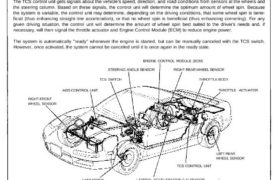System Description
Outline
Role of System
The NSX/NSX-T traction control is a variable system designed to enhance traction during acceleration and cornering. It
does so by determining the optimum amount of wheel spin for any given driving situation, then suppressing surplus
engine power accordingly.
This version of TCS has a lateral acceleration (Lg) sensor and a deceleration control function to improve traction control
during acceleration and deceleration while cornering. When downshifting quickly to a very low gear on a slippery surface,
the driving wheels tend to slip because of engine braking, resulting in lower directional stability. To counteract this, the
deceleration control function controls engine braking with the TCS control unit.
Construction and Function
The TCS control unit gets signals about the vehicle’s speed, direction, and road conditions from sensors at the wheels and
the steering column. Based on these signals, the control unit will determine the optimum amount of wheel spin. Because
the system is variable, the control unit may determine, depending on the driving conditions, that some wheel spin is bene-
ficial (thus enhancing straight-line acceleration), or that no wheel spin is beneficial (thus enhancing cornering). For any
given driving situation, the control unit will determine the amount of wheel spin best suited to the driver’s needs and, if
necessary, will then signal the throttle actuator and Engine Control Module (ECM) to reduce engine power.
The system is automatically “ready” whenever the engine is started, but can be manually canceled with the TCS switch.
However, once activated, the system cannot be canceled until it is once again in the ready state.
ENGINE CONTROL MODULE (ECM)
STEERING ANGLE SENSOR
TCS SWITCH
RIGHT-REAR WHEEL SENSOR
THROTTLE BODY
ABS CONTROL UNIT
RIGHT-FRONT
WHEEL SENSOR
THROTTLE ACTUATOR
LEFT-REAR
WHEEL SENSOR
LEFT-FRONT
WHEEL SENSOR
TCS CONTROL UNIT
LATERAL ACCELERATION (Lg) SENSOR
Components:
• Wheel sensors: The TCS “shares” the wheel sensors with the ABS. The wheel sensors transmit wheel speed signals to
the TCS through the ABS control unit.
• Steering angle sensor: The steering angle sensor signals the TCS control unit about the amount of steering angle.
• Lateral acceleration (Lg) sensor: The Lg sensor detects the lateral acceleration of the vehicle and signals the TCS con-
trol unit.
• TCS control unit: The TCS control unit detects the driving condition signals from the sensors and, if necessary, signals
the throttle actuator and the Engine Control Module (ECM). This version has a lateral acceleration (Lg) sensor, which
improves the traction control performance during cornering.
• Throttle actuator: The throttle actuator opens and closes the throttle valve according to the traction control signal from
the Engine Control Module (ECM).
Outline
Role of System
The NSX/NSX-T traction control is a variable system designed to enhance traction during acceleration and cornering. It
does so by determining the optimum amount of wheel spin for any given driving situation, then suppressing surplus
engine power accordingly.
This version of TCS has a lateral acceleration (Lg) sensor and a deceleration control function to improve traction control
during acceleration and deceleration while cornering. When downshifting quickly to a very low gear on a slippery surface,
the driving wheels tend to slip because of engine braking, resulting in lower directional stability. To counteract this, the
deceleration control function controls engine braking with the TCS control unit.
Construction and Function
The TCS control unit gets signals about the vehicle’s speed, direction, and road conditions from sensors at the wheels and
the steering column. Based on these signals, the control unit will determine the optimum amount of wheel spin. Because
the system is variable, the control unit may determine, depending on the driving conditions, that some wheel spin is bene-
ficial (thus enhancing straight-line acceleration), or that no wheel spin is beneficial (thus enhancing cornering). For any
given driving situation, the control unit will determine the amount of wheel spin best suited to the driver’s needs and, if
necessary, will then signal the throttle actuator and Engine Control Module (ECM) to reduce engine power.
The system is automatically “ready” whenever the engine is started, but can be manually canceled with the TCS switch.
However, once activated, the system cannot be canceled until it is once again in the ready state.
ENGINE CONTROL MODULE (ECM)
STEERING ANGLE SENSOR
TCS SWITCH
RIGHT-REAR WHEEL SENSOR
THROTTLE BODY
ABS CONTROL UNIT
RIGHT-FRONT
WHEEL SENSOR
THROTTLE ACTUATOR
LEFT-REAR
WHEEL SENSOR
LEFT-FRONT
WHEEL SENSOR
TCS CONTROL UNIT
LATERAL ACCELERATION (Lg) SENSOR
Components:
• Wheel sensors: The TCS “shares” the wheel sensors with the ABS. The wheel sensors transmit wheel speed signals to
the TCS through the ABS control unit.
• Steering angle sensor: The steering angle sensor signals the TCS control unit about the amount of steering angle.
• Lateral acceleration (Lg) sensor: The Lg sensor detects the lateral acceleration of the vehicle and signals the TCS con-
trol unit.
• TCS control unit: The TCS control unit detects the driving condition signals from the sensors and, if necessary, signals
the throttle actuator and the Engine Control Module (ECM). This version has a lateral acceleration (Lg) sensor, which
improves the traction control performance during cornering.
• Throttle actuator: The throttle actuator opens and closes the throttle valve according to the traction control signal from
the Engine Control Module (ECM).
